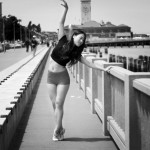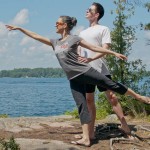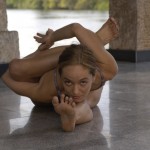A ballet dancer is constantly renegotiating her relationship with gravity; we rise on pointe as an expression of our desire to fly. Joie Brown’s beautiful watercolor triptych illustrates two important aspects of a dancer’s technique:
Well-developed arches of the feet, coupled with the ankle mobility needed to position the ankle bone over the toes en pointe
Dancers aren’t born with these feet! They develop mobility and strength over time with the right training. When we relevé in soft ballet slippers, our goal is to get as high as we can over our toes in three-quarter pointe, so that our body weight is supported in a straight line through the legs and ankles down to the narrow base that our toes form on the floor – this prepares us for the eventual ascent to full pointe.
Even if you never go on pointe, the sous-sus position – a tight 5th position relevé – is one of great strength, a launching pad for all sorts of adventurous extensions, jumps, turns and pivots, and a beautiful, streamlined pose in its own right. (Sous-sus translates into “under-over” which describes the placement of the feet and is a term from the Italian Cecchetti School; the French and Russian Schools call it sus-sous or “over-under” but it means exactly the same thing.)
A pliant lower thoracic spine, or middle back, which contributes to a deep backbend and a high arabesque
In a backbend or arabesque, the lumbar spine, or lower back, may seem to curve but it’s important to avoid a sharp curve in that area, instead employing the greater mobility of the lower thoracic spine, which is the section above the lumbar. The lumbar spine should be supported in backbends and arabesques by strongly engaging the abdominal core muscles.
In the one-handed cambré press lift depicted here, the man’s flattened palm creates a “shelf” on which the ballerina must place her upper back. It may look like he is doing all the work, but the ballerina has to initiate the lift with a well-timed jump, arch the thoracic spine, broaden the upper back, engage her abs strongly, lengthen the lumbar spine and the front of the hips, and use her head and arms to counterbalance the weight of her lower body.
Her partner has to ensure that the ballerina’s centre of gravity is positioned directly over his – her weight fully supported through his arm with elbow locked, down through his shoulder and spine, all the way to the floor; her weight should not be cantilevered at a distance away from his centre of gravity, which would put undue stress on his joints and risk her toppling over.
More of Joie Brown’s graceful art can be seen on her website http://www.joieart.net while Joie’s graceful dancing can be seen at City Dance and the Mary Sano Studios.






